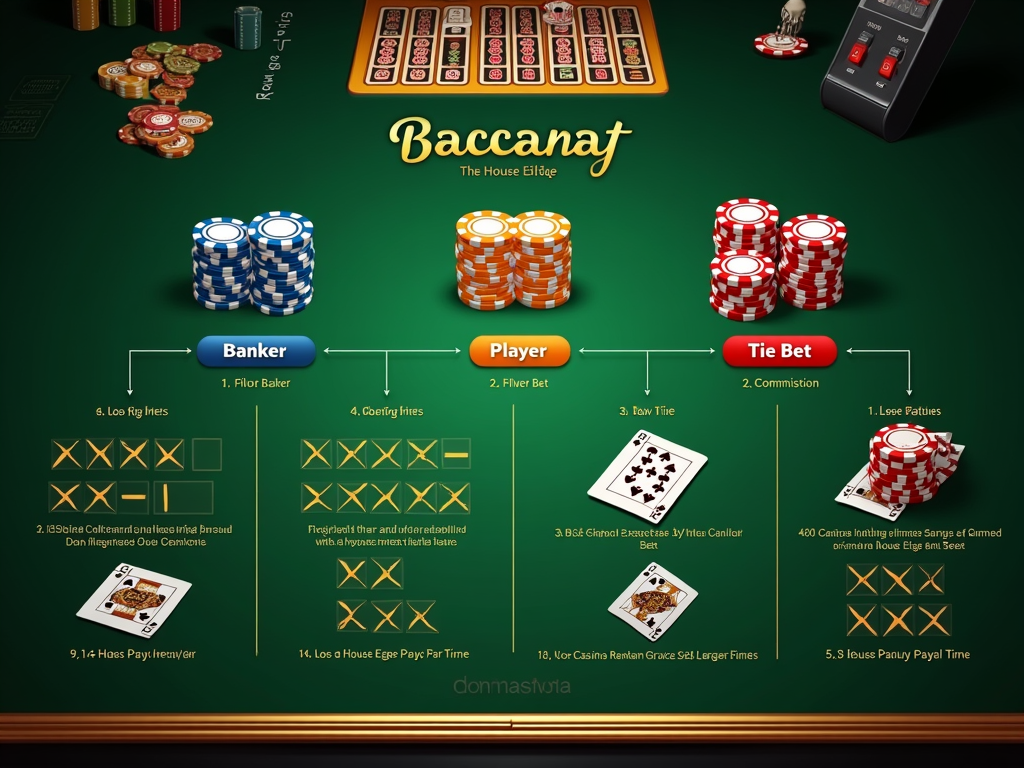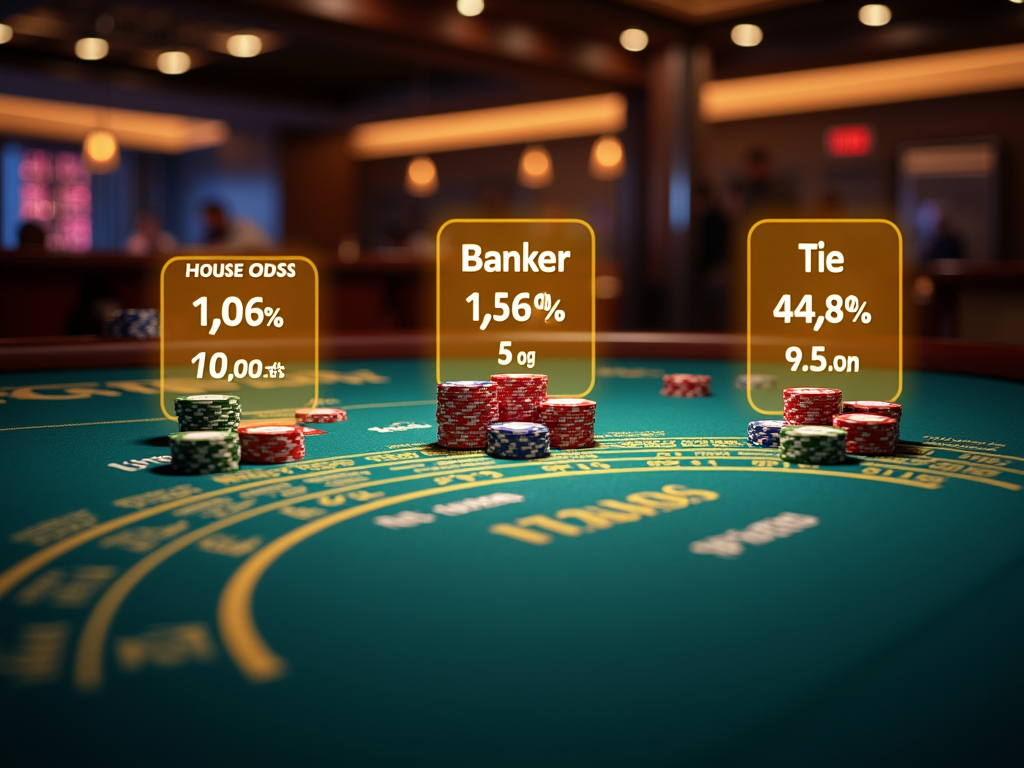Baccarat Betting Strategy: Why the Banker Bet Leads
In the game of Baccarat, choosing the right betting strategy is crucial for maximizing your odds. Among the available options, the Banker bet stands out statistically, offering players the best chances for success, even with a minor deduction through commission.
Understanding the House Edge
Each betting option in Baccarat comes with its own house edge, which directly affects your long-term outcomes:
- Banker Bet: 1.06% house edge with a strong 45.86% win rate, even with a 5% commission on wins.
- Player Bet: 1.24% house edge and no commission, making it the second-best option.
- Tie Bet: A steep 14.36% house edge places this as the least favorable choice.
Key Takeaways
- Banker bet offers the lowest house edge at 1.06% and the highest win rate at 45.86%.
- Player bet provides commission-free wins with a slightly higher house edge of 1.24%.
- Tie bet should generally be avoided due to its extremely high house edge of 14.36%.
- The 5% commission on Banker wins is outweighed by its superior win frequency over time.
- Both main bets — Banker and Player — statistically offer better odds than most other casino games.
Recommended Strategy
I recommend sticking to Banker bets for optimal results. Despite the 5% commission on Banker wins, the superior win rate makes it the most logical and profitable choice in the long run.
Using the Player bet as a secondary option is reasonable, providing a break from commission fees while maintaining strong odds. However, the Tie bet should be consistently avoided due to its significantly inflated house edge, which can lead to major losses over time.
Ultimately, the statistical analysis makes it clear: Banker and Player bets are the strategic backbone of any successful Baccarat game. Focus your approach on these two bets and avoid the Tie bet to achieve the best long-term results.
Why the Banker Bet Gives You the Best Odds in Baccarat
Breaking Down the Banker Bet Advantage
The Banker bet stands out as the smartest choice in Baccarat with its low house edge of 1.06%. I’ve found this to be the most reliable betting option, even with the standard 5% commission taken from winning bets.
Let me paint a clear picture of how the Banker bet works in practice. When placing a $100 bet on the Banker hand and winning, you’ll receive $95 after the commission is deducted. While paying this commission might seem frustrating at first, the math proves it’s still your best option at the Baccarat table.
The numbers tell the real story here. The Banker bet wins 45.86% of all decisions (not counting ties), making it statistically superior to other betting options. This higher win rate compensates for the 5% commission, creating a mathematical advantage that can’t be matched by other bets in the game.
Key Reasons the Banker Bet is the Smartest Option
- Lowest house edge of all Baccarat bets at 1.06%
- Highest win probability at 45.86% (excluding ties)
- Consistent 1:1 payout structure (minus commission)
- Most stable long-term betting option
I always stress to players that while the commission might seem like a drawback, the increased winning frequency makes up for this cost. The combination of higher win rate and relatively small house edge creates a betting option that gives you the best chance to maintain your bankroll over time.
Understanding the Second-Best Option: The Player Bet
Breaking Down the Player Bet’s Value
The Player bet offers a straightforward option in Baccarat with its clean 1:1 payout structure. When you win a $100 Player bet, you’ll receive $100 in winnings—no complicated commission calculations needed. That’s a significant advantage for tracking your returns during gameplay.
The Player bet carries a house edge of 1.24%, making it a solid choice for Baccarat players seeking favorable odds. While this edge is just 0.18% higher than the Banker bet, the absence of commission payments can make the Player bet more appealing for certain betting strategies.
Here’s what makes the Player bet worth considering:
- Win probability stands at 44.62%, providing frequent winning opportunities
- No commission deductions on winning bets
- Simple 1:1 payout structure makes bankroll management easier
- Clear-cut odds make it easy to track expected returns
- House edge remains competitive at 1.24%
The Player bet’s transparency in payouts can help you maintain better control over your betting patterns. Eliminating commission calculations allows for quicker decision-making at the table. This straightforward approach lets you focus on the game’s rhythm rather than getting caught up in complicated payout math.
The relatively high win probability of 44.62% means you can expect consistent returns during your gaming session. This regularity helps smooth out the natural swings that come with casino games, making the Player bet an excellent choice for those who prefer a balanced approach to Baccarat betting.
Why You Should Almost Never Make the Tie Bet
Understanding the High House Edge
I can’t stress enough how the tie bet carries a staggering 14.36% house edge in baccarat when paid at the standard 8:1 odds. That’s significantly higher than the player (1.24%) or banker (1.06%) bets. Put simply, for every $100 wagered on tie bets, you’re expected to lose $14.36 over time.
The casinos make this bet tempting by displaying the potential $800 payout on a $100 wager. However, the cold reality is that tie hands only occur 9.52% of the time – less than one in ten hands. This combination of rare occurrence and high house edge makes it one of the poorest betting choices at the baccarat table.
The Rare Exception
Some casinos offer modified tie bet payouts at 9:1 instead of the standard 8:1. This reduces the house edge to 4.84% – still high, but considerably better than 14.36%. Here’s why the tie bet remains problematic even with improved odds:
- Your money is still more likely to be lost than other baccarat bets
- The actual occurrence rate stays fixed at 9.52%
- The expected loss per $100 is still $4.84 with 9:1 payouts
- You’d need to hit ties more than twice as often just to break even
The math clearly shows why experienced baccarat players skip the tie bet. While the allure of a big payout is strong, the combination of infrequent wins and a massive house advantage makes this wager statistically unsound for any serious player focused on extending their bankroll and maximizing their chances of winning.
The Math Behind the House Edge
The house edge in baccarat creates a built-in advantage that lets casinos stay profitable while still offering players fair gameplay opportunities. I’ll explain how this mathematical concept works and why it matters for your betting decisions.
Breaking Down the House Edge
In baccarat, each betting option comes with a specific house edge percentage that affects your potential returns. The casino’s advantage gets calculated by comparing the true odds of winning versus the actual payout odds offered. Here’s how the different bets stack up:
- Banker Bet: 1.06% house edge with 5% commission on wins
- Player Bet: 1.24% house edge with no commission
- Tie Bet: 14.36% house edge with higher payout ratio
The casino’s edge ensures they’ll make money over time through the law of large numbers. For every $100 wagered on the banker bet, the house expects to keep $1.06 on average. While individual sessions can swing either way, this mathematical advantage guarantees casino profits across thousands of hands.
These percentages put baccarat among the most player-friendly casino games. Even with the banker’s 5% commission, both main betting options offer considerably better odds than most slot machines or carnival games. The tie bet stands out as significantly less favorable, which is why experienced players typically avoid it despite its attractive 8:1 or 9:1 payout.
I always emphasize focusing on these core percentages rather than getting caught up in betting patterns or trends. The house edge remains constant regardless of previous outcomes or betting systems used. Understanding these numbers helps make smarter betting choices aligned with the true probabilities rather than hunches or superstitions.

Breaking Down Your Actual Odds of Winning
The Statistical Reality of Each Bet
I can tell you straight up – baccarat presents distinct win probabilities for each betting option. The Banker bet comes out ahead, winning 45.86% of all hands played. The Player bet follows closely behind at 44.62%, while Ties happen in 9.52% of cases.
Understanding The House Edge Impact
Even with the 5% commission charged on winning Banker bets, it still stands as your most favorable option mathematically. Here’s why this matters for your gameplay:
- The Banker bet maintains a slim house edge of just 1.06%
- Player bets carry a slightly higher house edge at 1.24%
- Tie bets face a steep house edge between 14.4%
These percentages directly affect your long-term winning potential at the baccarat table. When you’re placing Banker bets, you’re cutting into the casino’s advantage with the best odds available. The small commission might seem like a hassle, but I’d say it’s a fair trade-off for getting the most statistically solid bet in the game. The difference between Banker and Player bets may look tiny, but in gambling, every fraction of a percentage point counts in your favor.
Don’t let the 5% commission on Banker bets throw you off – it’s factored into these house edge calculations. The Banker’s superior win rate more than makes up for this fee, which is why experienced players often stick to this option despite the extra charge. Even after paying the commission, you’re still working with better odds than the Player bet offers.
Making the Smartest Bet in Baccarat
Breaking Down the Three Main Bets
I’ve found that understanding the house edge for each betting option in Baccarat helps create a solid foundation for smart gameplay. Let’s look at the hard numbers behind each bet type.
The Banker bet stands out with its 1.06% house edge and impressive 45.86% win rate. Despite the 5% commission charged on winning Banker bets, it remains statistically the safest choice at the Baccarat table.
The Player bet comes in as a close second with a 1.24% house edge and 44.62% win rate. While the difference might seem minimal, it adds up significantly during extended play sessions. The Player bet doesn’t require a commission payment, which makes it straightforward to calculate potential returns.
The Tie bet is the least favorable option with a steep 14.36% house edge. Though it offers attractive 8:1 or 9:1 payouts, it only occurs 9.52% of the time. This makes it a high-risk proposition that can quickly deplete your bankroll.
Why the Banker Bet Prevails
The mathematical superiority of the Banker bet becomes clear when examining long-term play. Even after accounting for the 5% commission, the Banker bet maintains the lowest house edge of all three options at 1.06%.
Here’s what makes the Banker bet the optimal choice:
- The drawing rules slightly favor the Banker position
- The win probability exceeds both Player and Tie bets
- The house edge remains consistent regardless of deck number
- The commission fee is offset by the higher win rate
Over thousands of hands, the 0.18% difference in house edge between Banker and Player bets translates into substantial savings. While both betting options can lead to winning sessions, the Banker bet consistently proves to be the most reliable choice for serious players focused on maximizing their chances of success.
The numbers speak for themselves – the Banker bet is the clear winner for players seeking the most mathematically sound approach to Baccarat. Though some players might be tempted by the allure of Tie bet payouts, the significantly higher house edge makes it an impractical choice for sustainable play.

Sources:
Wizard of Odds – Baccarat
Vegas Advantage – Baccarat
Casino.org – Baccarat Odds and Payouts





